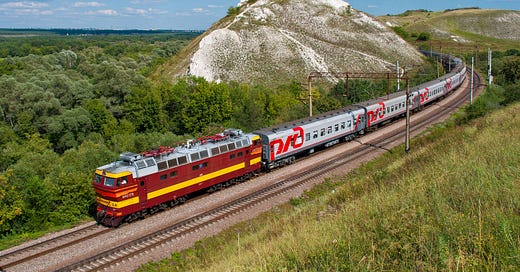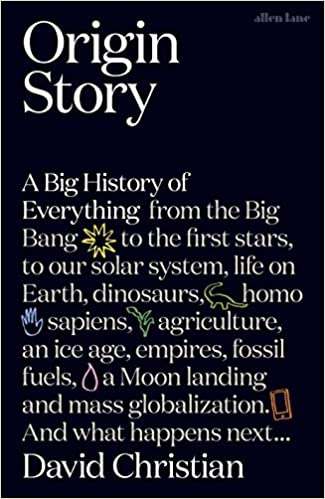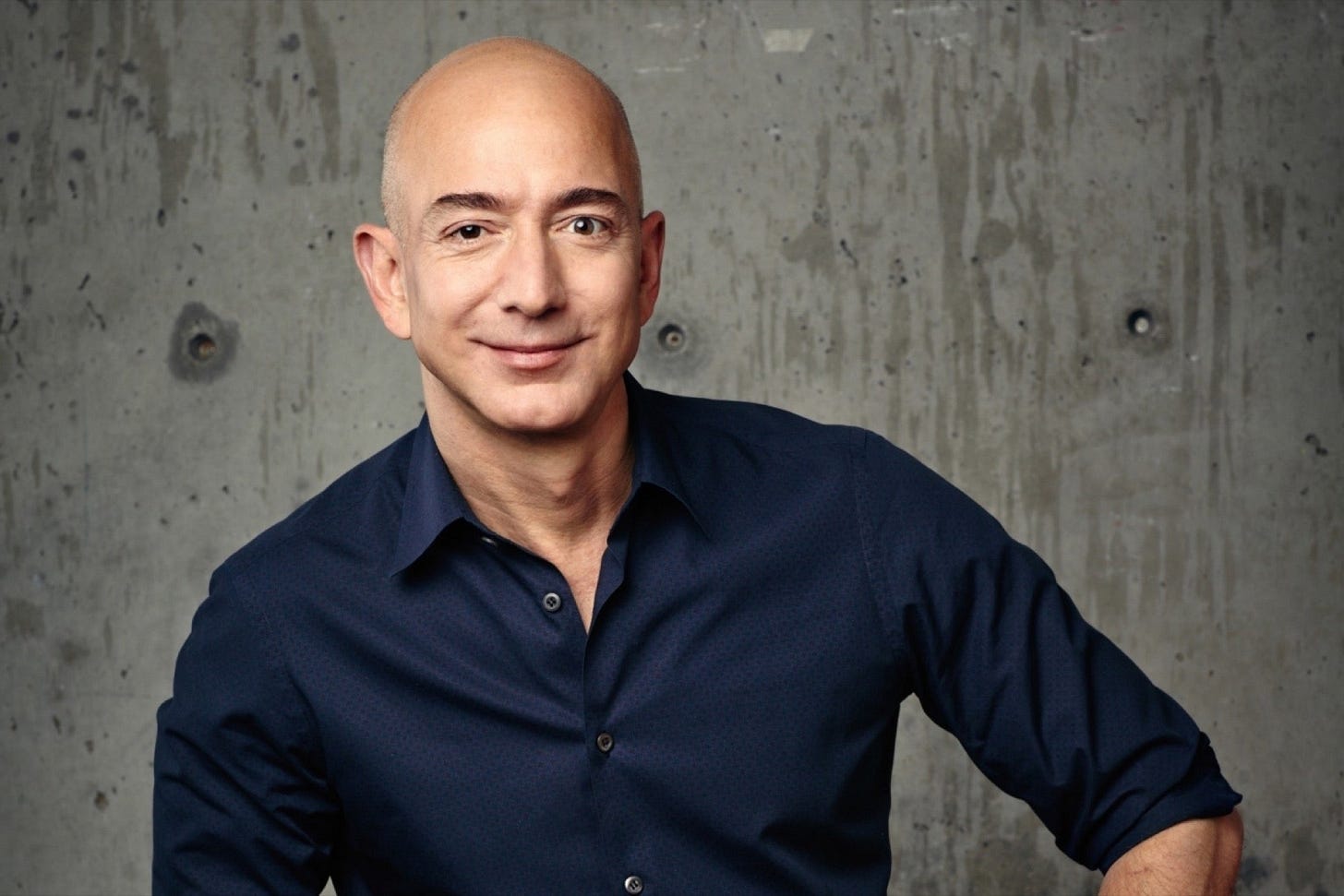Energy has captured my mind. Ever since reading the book 'Origin Story' by David Christian, I cannot help thinking in terms of energies.
But let me take a few steps back and go on a short detour (a detour so early into the article! Yikes!). I love reading. I have loved reading ever since I was a kid. You see, I was an irritating little chap, and my mom decided the only way her sanity could survive the periodic long train journeys to her sisters' was if I could be encouraged to keep my mouth shut. She loved reading too and decided to share that love with me. And I have been hooked since.
I agree with Naval Ravikant's idea that the best way to develop a fascination for reading is to read what you love till you love to read. I guess my mom intuitively understood and encouraged that. I love reading for its own sake - with no agenda other than to explore the world that the author has so painstakingly created.
I did not know it, but I think I was subconsciously searching for a job where the primary demand would be reading. It was on this search (that I was ignorant of) that I stumbled serendipitously across Prof Bakshi at my business school. In his introductory class, he confessed that he intended to play a trick on us (like one of his teachers Charlie Munger frequently does) - he intended to use finance as an excuse to teach us common sense and impart some worldly wisdom.
The course changed my life- literally. Prof took us with him on a beautiful journey and introduced us to other luminous teachers like Munger, Buffett, Taleb, Jiddu Krishnamurthy, Dr. V, among many others - people who were pioneers in the way they plumbed the depths of their soul and explored the uncharted waters of the human spirit within them.
All that was required of us, Prof said, was to read and think - interspersed with a little bit of doing.
Of the teachers that Prof brought into my world, Charlie Munger is a major favourite. In his teachings, I found an excuse to do what I love. Mr. Munger pointed out that the investment world is a subset of human systems, and human systems are a subset of the grand universe. Thus, if we want to do well in investing, it follows that we try and understand how the world and the universe works.
Well, this made perfect sense to me - perhaps it helped that I was supremely self-incentivised to believe this. I arm myself with this excuse and buy all sorts of random books to my wife's chagrin. It is a 'discussion' that has so far tilted in my favour - just barely.
Anyways, let us end this detour and come back on our original journey - Origin Story and Energies.
In my quest to learn more about the world, I stumbled across the book 'Origin Story' by David Christian. Most of what I read is as a result of stumbling, but there was something poetic about this particular stumble. What better way to learn about the world we live in than to read a brief history of the entire universe - right from the Big Bang to where are today?
This particular book was a treasure trove in that it provided a number of frameworks applicable to the subsystem of investing. Without further ado, allow me to share my interpretation of some of the concepts and its applications in investing. All mistakes in anything I write is entirely mine.
Let us begin with Activation Energy.
Here are a couple of excerpts from the book describing activation energy and its role in the formation of the universe and its components.
The birth of stars - Gravity had kick-started the transformation of matter into stars by fusing protons despite the barrier created by their positive charges. This is a pattern we will see over and over again. It's a bit like the cup of coffee that helps you get going in the morning. Chemists refer to this initial shot of energy as activation energy; it's the energy of a lit match that starts a conflagration. One kind of energy changes something so as to release other flows of free energy that are much greater than activation energy. In the story of star formation, gravity provided the activation energy for fusion and star formation and for all that followed.
Engine - The James Watt steam engine gave a first taste of energy flows so vast that they would transform human societies in just two centuries. Like the activation energies that kick-start chemical reactions, energy from fossil fuels provided a pulse of energy that started technological equivalent of a global chain reaction.
Next we have Potential Energy. Here is the excerpt on potential energy:
How did humans know how to get more crops from the same amount of land? How, in fact, did they know how to farm? This is where the power of collective learning is most apparent. Most other species faced with similar ecological crises would have hit a demographic brick wall. That wall explains the familiar S-shaped curve of population growth in most types of organisms: a new species multiplies until it is extracting all the food energy in its niche, after which individuals starve, fertility falls, and population growth plateaus. Humans had more options because they had more information. Much of that information had not been needed before. It was potential knowledge, like potential energy - knowledge held in reserve that could be activated if and when it was needed. Modern foragers have a lot of potential knowledge that can be activated if and when it is needed. Most of the time, the foragers don't bother with these technologies, because they aren't needed, and they require a lot of extra work.
____
Both the ideas are powerful individually, but when taken together, they point to a really useful model in the investing niche. This resulted in a tentative framework in my mind.
Tentative framework - Using activation energy to unlock potential energy in an asset.
There are more than 5,000 listed businesses in India. In this large number, there are inevitably businesses that seem super cheap in context of the underlying value. The underlying value can be thought of as akin to potential energy.
But in most cases the potential energy remains trapped. What we refer to as 'value trap' in investing is akin to such blocked or trapped energies. The trapping of value or energy tends to occur due to misalignment - one example is the misalignment between what is good for the management / promoters and what is good for the business; or value could be trapped because of the point of time in the business cycle.
Hotel businesses are a good example of difficult-to-tap potential energy. Some listed hotel businesses have huge underlying asset values - the construction cost of land and building of a large hotel is generally a large multiple of the quoted enterprise / market value. On average, a favorable cycle or an asset sale is necessary to unlock value in owned assets in a hotel business.
In general an idea to remember is - investing in potential energy with no activation energy to unlock the energy can lead to a value trap.
There are many applications of the above framework in investing - change in management of a mismanaged quality asset, 'learning machine' management that rectify past mistakes, and others. Here is an exploration of one particular application as an example to understand the model better.
Tentative sub-framework - Change in management in a mismanaged high quality asset / Learning managements
One more detour - genetics.
Behavioural science has emphatically proved our species' dislike for uncertainty. The reason is genetic - in the hunter- gatherer world, the forager homo sapiens lived in tribes and were definitely not the apex predator. There were many other species much more dangerous and our survival was constantly under threat. In such a world, it can easily be understood why uncertainty equaled risk. An uncertain movement in the nearby bush is a potential danger to one's very survival. The odds at the time and in that context were such that bravery in the face of uncertainty meant death.
While the modern human lives in very different conditions, the genetic wiring remains the same. Essentially, the social and cultural evolution of our species has been much faster than biological evolution. In financial markets in particular, this genetic wiring, which has played such a pivotal role in our survival, gives off wrong signals. In addition to this uncertainty avoidance, herd mentality and social proofing comes in as well -when enough people avoid uncertain situations, then even more people avoid it - as there is perceived safety in acting like your peers do (yet another genetic wiring which was essential for survival). All of these together results in a lollapalooza outcome - the average human mind craves certainty and wants to be part of the crowd - it wants predictability, consistency and it also finds safety in numbers.
Now why does all this matter?
As Prof Dumbledore said in the 'Goblet of Fire' about Harry Potter - “Understanding is the first step to acceptance, and only with acceptance can there be recovery.”
I would reframe this slightly differently - "Understanding the problem is the first step to solving the problem."
If majority of the world thinks uncertainty equals risk and one finds situations where uncertainty does not equal risk, then uncertainty becomes an opportunity for the introspective participant.
I believe some of the best opportunities arise in the market where there is low downside, but extremely uncertain upside. The uncertainty in the situation tends to eat up major portion of the mental capital of the market participants (because of the aforementioned genetic wiring) - they don't seem to notice or are unable to rationally assess the downside. The uncertainty in the situation tends to block their ability to think about anything else - its just too uncomfortable and the mind just wants to move on.
______________
Now, let's return from our detour. How does understanding the importance of uncertainty help us apply the sub-hypothesis?
Let's break down the framework - change in management of a mismanaged quality asset - into its two component parts: 1) mismanaged quality asset, 2) change in management.
A mismanaged quality asset is akin to untapped potential energy. Mismanagement leads to misalignment of energies, and potential energy tends to be trapped in the asset. In our context, the extent of untapped potential energy is the replacement / private value of the asset in relation to the enterprise value of the company at that time.
Change in management is akin to the activation energy. It pays to remember here chemistry's definition of activation energy - it's the energy of a lit match that starts a conflagration. One kind of energy changes something so as to release other flows of free energy that are much greater than activation energy (emphasis mine). When new management is brought to turn around the ship, and if they are rightly incentivised, it tends to act as activation energy.
In effect, there are two major conditions required - huge potential energy which basically means huge underlying value in the asset; and activation energy that leads to the unlocking of potential energy.
Let us now turn to an example which will make the idea less abstract hopefully - Mahindra Lifespaces.
Mahindra Lifespaces is majority owned by the M&M group . Till 2020, Mahindra Lifespaces was a real estate developer trying to do a lot of things - it had SEZs, industrial clusters, holiday homes, affordable housing projects, mid-premium and premium projects in various locations across the country ranging from Gurgaon, Nagpur, Mumbai, Chennai, Bangalore, etc.
Let us apply the framework discussed above:
Potential energy -
I consider the asset mismanaged as it was among the smallest businesses in the Mahindra group and was in a sector where its peers had created much larger value for its shareholders. In 2020, the company had a market cap of around 1,000cr ($130 million).
In relation to that, it had a 68 acre parcel in Thane (worth 500-1000cr), thousands of acres of land in the industrial cluster business (worth between 2000-4000cr), unfinished projects worth a good amount and access to M&M land parcels around the country.
Most important of all, it enjoyed the benefit of the Mahindra brand. There are very few brands which travel across India and enjoy the trust of the public, and Mahindra is one of them. This trust was a major advantage in a sector which was plagued by a number of issues and where the customer had effectively lost trust. Trust was a truly scarce commodity in real estate sector, and in that context, access to the Mahindra brand was a major advantage.
Activation energy -
In 2020, Arvind Subramanian was appointed as the new CEO of the company. Mr. Subramanian had an accomplished professional career before he took over the mantle at Mahindra Lifespaces. He took a number of actions to tap the potential energy in the company, and unleash other flows of free energy. The entire top management was revamped with many of the hires coming from much larger entities. He sharpened the focus of the organization by exiting / reducing focus on non-core areas and sharpening focus on core areas. Sharpening focus is a great way to tap into energy as then one can bring more energy to bear on fewer things - perhaps more on this in a separate post.
While Mr. Subramanian's appointment is the proximate cause, the ultimate cause is a similar event taking place at the Mahindra Group level. His appointment seems to be part of the broader changes at the strategic direction at the Group level. Dr. Anish Shah took over as the Chairman of the Group and activated a whole host of similar changes like rationalising underperforming units, sharpening focus, doubling down on areas where Mahindra can leverage its brand advantage.
Over the last three years, the outcome of the above has been quite favorable with the valuation multiplying more than 3x and the business is to be included in the Realty Index in the next couple of months.
___________
There are more examples out there. CG Power is an extreme example - it had large potential energy in that it was the dominant player in a number of large segments and the energy was hidden due to evident reasons. The acquisition by Murugappa group unleashed the dormant energy in the business.
Eveready is another example. The business enjoyed a dominant market share and strong brand recall, but the business was under cloud due to the erstwhile family's troubles. When Burmans built their stake, the risk-reward improved tremendously. Dabur itself is an excellent example of the Burman family's ability to oversee a professionally run branded business.
The best part about being in India at this point in time in its evolution is that there are a number of similar examples out there.
_______________
Let us go back to the book 'Origin Story' again to figure out some of criteria. As discussed above, the book is about the evolution of the universe from the time of the 'Big Bang'. One way to describe the evolution is to see the universe as a system, and the system's ability to tap into innovations that tapped new and larger forms of energy. These new sources of energy enabled the system to evolve into more complex systems. In general, directed free energy flows into a scalable system are vital for its growth.
Let us take an excerpt from the book to understand the idea better:
"The most important mega-innovations were usually those that released new flows of energy, such as fusion or photosynthesis. Farming counts as a mega-innovation because it let farmers tap larger shares of energy flows from recent photosynthesis. But there were limits to the energy flows from farming, because it tapped only recently captured sunlight. Burn a piece of wood, eat a carrot, or harness a horse to a plow, and you are tapping energy flows captured from sunlight in the past 12 months or at most in recent decades.
The energy flows that powered human societies came from croplands and woodlands, with a small bonus from wind and rain. So growth meant finding more arable land and woodland. By 1800, it seemed that most farmable land was already being farmed. Adam Smith argued that societies would soon be using all available energy. Then growth would stall; wages would fall, and so, too would populations as farming societies came face to face with the limits on energy flows that all other organisms do when they have filled up their niche. Some societies, such as Netherlands and England, already seemed to be pushing at these limits. In the Netherlands, farmers had to gouge farmland from the sea, while England faced growing shortages of timber for heating, housing and shipbuilding.
Pressure to find new sources of energy would eventually conjure up the mega-innovations that we describe today as the fossil-fuels revolution. These gave humans access to flows of energy much greater than those provided by farming- the energy locked up in fossil fuels, energy that had accumulated not over a few decades but since the Carboniferous period, more than 360 mio years earlier.
Like a gold strike, this energy bonanza generated frenzied and often chaotic new forms of change and created and destroyed the fortunes of individuals, countries and entire regions. "
Using the above model, let us turn back to our sub-hypothesis. The best outcome occurs when there are multiple overlapping energies moving in the same direction - analogous to the lollapalooza model.
In some of the best examples, when top management change happens in a badly run high quality asset, this activation energy results in further unleashing or more efficient tapping of more dense forms of energy. Here are a couple of examples:
Human spirit:
A mismanaged business tends to have demotivated employees. There is resistance to working efficiently and the business tends to be mired more in bureaucracy and paper pushing. I believe that human characteristics like ambition, confidence, enthusiasm, envy, etc are all forms of energy, which when properly tapped can lead to tremendous outcomes. Culture, in my mind, is a measure of the efficiency of how an organisation or a system taps the positive spirit (energy) of its employees or a nation. The right leader can unleash tremendous energy by tapping into the earlier mentioned energy sources like ambition, enthusiasm, etc. Imagine the power when a group of motivated, ambitious, capable individuals focus towards a single goal that is larger than themselves. It is akin to a fusion reaction - similar to how when smaller nuclei combine to overcome the natural repulsive forces with tremendous release of energy, when individuals align together towards a common aim tremendous energy is released.
This tapping of energy can happen not just within a system but across the ecosystem. For example, take Hercules Hoists, the leading hoists manufacturer in the country, where a new CEO Mr. Amit Bhalla was appointed in Jan 2021. Indications are that not just employees, but even distributors are energised by the changes initiated by the new CEO. He has facilitated a more consultative approach and rather than creating blockages, he has removed obstacles to the flow of the entrepreneurial energies of the distributors.
Tailwinds:
"There are tides in the affairs of men, which when taken at a flood leads to good fortune." Tailwinds are powerful sources of returns. It is my belief that a major portion of the returns (and drawdowns) for some of the best (worst) performing stocks tend to be driven by the sectoral tailwinds. When harnessed correctly, they can make a tremendous difference to the portfolio. In my framework, I rarely participate in a business which is going through long-term sectoral headwinds.
Going back to our example of Mahindra Lifespaces, the turn in the real estate cycle is an important component of returns. A sectoral tailwind is like a rising tide that lifts all boats, but a well run boat can rise further than most other boats in the sea. Absent the tailwinds, the outcome of a situation with activation energy is subdued.
______
A key question in such situations is - When should one invest in such situations? Should one invest at the time of change or after seeing evidence of the positive trajectory?
Jeff Bezos' opinion on decision making fits here best - "You have to realize: decision making isn’t one size fits all. To know the difference, ask yourself two simple questions: What are the consequences of this decision? and Is this decision reversible? Most decisions should probably be made with somewhere around 70 percent of the information you wish you had. If you wait for 90 percent, in most cases, you’re probably being slow.”
The best approach is to perhaps compare the situation to a broad set of criteria or guidelines. It helps to see both the number of the criteria that is met by the situation and the intensity with which it is met. Basically, bet large when the odds are in favor.
Here are some criteria that I keep in mind when applying the framework. I have a very short experience in applying this framework and wanted to lay a broad set of guidelines for this approach. They are not laws or rules but broad principles.
Magnitude of potential energy - There has to be large difference between the current market value (blocked energy) and the replacement / private value (potential energy) of the company. The larger the difference the better. This is because, in human systems, contrast and momentum both matter. This is perhaps an application of the contrast bias tendency in humans - our sensory perception is more tuned to changes in degree than the absolute degree of anything (simultaneously dip one hand in hot water and one in cold water for a minute, and then simultaneously dip both hands in room temperature water). When the underlying potential energy is large, the unlocking of it can catapult the business tremendously - the contrast bias perception drives momentum and the market moves from under-recognition of value to over-recognition of value.
Mismanagement - It is strange to wish for mismanagement as an investor, but this goes back to the previous point. Mismanagement of a high quality asset is what leads to a large difference between the blocked energy and the potential energy in the company. A well managed asset changing hands might unlock a lot of value. Shanthi Gears is a good example - it was a very well run business that was taken over by the Murugappa group in 2012. As it was a well run business, there was not a lot of inefficiency to unlock.
Complexity of business- I will probably write out a longer post on this, but complexity in general is an enemy of scale. It is a feature of the universe that more complex structures have more moving parts and thus require more energy to scale. I stay away from textile industry as I believe the business structure is quite complex - capital intensive, labour intensive, government dependent, no control over raw material or finished goods prices and dependent on global macro factors. However, this does not mean the framework won't work. Gokaldas Exports is an example - it had large potential energy (one of the largest players in India) and had activation energy (S Ganapathi appointed as CEO). Since his appointment in 2017, the stock is up ~5x due to the changes instituted by him and the tailwinds in the sector.
Tailwinds - Having already covered this, I don't want to harp on this further. But this is a very important variable. If there are headwinds, a change in management need not necessarily work. Shanthi Gears is an example here. In 2012, Murugappa group acquired the business. But this was the beginning of the downturn in the capital cycle, which hit the business.
Share structure - It helps to have a strong group as the major shareholder. This allows for actions that are long-term oriented in nature which generally attracts the best of talent and resources, and there is coherence in the strategy. When the tiller is not held by a strong hand, it can lead to the ship traveling astray. Take Care Ratings for example, there is no single majority owner - the board drives the agenda in the business. Long term oriented decisions require short-term sacrifice of profits, or as Thomas Russo would say, the structure should have the capacity to suffer. Will the board be able to drive the long-term agenda or will they be prisoner to short-term incentives? Time will tell.
Alignment - Just change in the top management is not enough. There needs to be alignment as well - replacement of one mismanagement with another will not unlock value.
Space and time - Revitalising a business is not an easy task; it requires time and resources. There should be adequate availability of resources including patience and independence, which allows the new management to do what is necessary to right the course of the ship. There are cases where the founding family has the intent to revitalize its business, and hires a professional outside CEO to run it. But then, in reality, it is unable to let go of the reins - the professional CEO is constantly interrupted or second-guessed in his / her decisions. On one hand you have the professional CEO trying to bring in changes as he sees fit, and on the other hand, you have the family who are unable to let go. This clash inevitably results in the professional exiting the business. This is not necessarily a bad thing, but a thing to be observed and analysed. This happened in Wonderla when a professional CEO (DS Sachdeva) was appointed for a short while. It might also have happened at Eicher Motors, where Mr. Dasari exit within two years.
Don't jump the gun - It generally makes sense to wait for the change to happen before one decides to participate. For example, in the last few years, there has been a lot of noise in India around PSU disinvestment. The delay in many cases have been material. Positioning for an event to play out can be a long (and painful wait).
______
GEICO and Potential energy
It might be a coincidence but I find the timing around Buffett's investment in Geico intriguing. The story of Geico is legendary in the lore of Berkshire Hathaway. It was Lorimer Davidson of Geico who taught Buffett the intricacies of insurance. After flirting with it briefly in 1951, he bought a large chunk of the business in 1976.
Buffett was always a fan of Geico's low cost advantage and its distribution network (potential energy). He believed as long as these durable advantages remained in the core auto insurance business, its success was inevitable. But Geico went through a series of problems in 1970s ranging from difficult industry conditions and deworsification by the management. It was severely under-reserved and on the edge of bankruptcy; its share price collapsed from $61 to $2.
Jack Byrne was brought in by the board to turn the company around. Buffett had continued to track Berkshire since the 1950s and got interested at this juncture. He made the effort to meet Jack Byrne and after a few hours' conversation with him decided to back Geico. He bought shares in the company from the open market and heavily participated in the convertible debt offering run by Salomon to raise capital to revitalise Geico.
The rescue and subsequent thriving of Geico follow the same pattern - a mismanaged quality asset that witnessed a shot of activation energy via Buffett and Byrne.
_______________
A word of caution - it is not a given that the framework will work. As Munger says, the best truths are those from hard sciences like Physics and Mathematics. Here, we are trying to apply some concepts in hard sciences to a complex system. The framework is a derivative and thus its 'trueness' is not as hard or true as that of hard sciences.
If the framework is able to tilt the odds ever so slightly in our favor, that will be more than enough.
I also wanted to reiterate that the sub-framework discussed above is just a subset of the larger framework - Potential energy lit by Activation energy. There are many other applications of the larger framework- learning managements (rectifying errors of the past), apoptosis (killing a segment to focus), corporate actions, etc.
I thought it best to end with a list of examples from India where I found application of this framework - Crompton Greaves Consumer, CG Power, Kirloskar Pneumatic, Mahindra Lifespaces, Hercules Hoists, Reliance Nippon Asset Management, Orient Bell, Tube Investments, Hindustan Oil Exploration, Selan Exploration, and many others.
Disclaimer: Please assume that I am not invested in any of the companies mentioned in the post
The End.














An update to the post:
I recently began reading 'Only the Paranoid Survive' written by the erstwhile CEO Andrew Grove. It is a fascinating book on the idea of 'Strategic Inflection Points' in the journey of any corporation. In the book, Mr. Grove refers to situations where new management can perform much better than old management - even when there is no difference in skill between both. His reasoning was interesting and I found it relevant to the post above. Below is one excerpt:
"Senior managers got to where they are by having been good at what they do. And over tie they have learned to lead with their strengths. So it is not surprising that they will keep implementing the same strategic and tactical moves that worked for them during the course of their careers- especially during their 'championship season.'
I came this phenomenon the inertia of success. It is extremely dangerous and can reinforce denial."
Here is another excerpt:
"Ever day, it seems, leaders who have been with the company for most of their working lives announce their departure, usually as the company is struggling through a period that has the looks of a strategic inflection point. More often that not, these CEOs are replaced by someone from the outside.
I suspect that the people coming in are probably no better managers or leaders than the people they are replacing. They have only one advantage, but it may be crucial: unlike the person who has devoted his entire life to the company and therefore has a history of deep involvement in the sequence of events that led to the present mess, the new managers come unencumbered by such emotional involvement and therefore are capable of applying an impersonal logic to the situation. They can see things much more objectively than their predecessors did."
I loved reading your Article, very informative and inspiring. Thank you for sharing your knowledge Rohith. Wishing you all the very best in life.